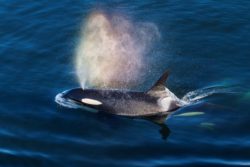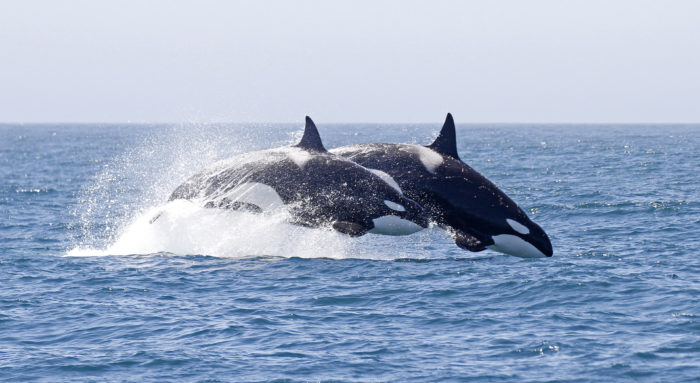
Sea Wonder: Orcas
 Orcas (Orcinus orcas) are the largest species of odontocetes, or toothed whales, and are actually part of the dolphin family. They are known as killer whales or the “wolves of the sea” due to their intelligence and ruthless hunting behavior and are held in high regard in many cultures all around the world for their mystery and majesty.
Orcas (Orcinus orcas) are the largest species of odontocetes, or toothed whales, and are actually part of the dolphin family. They are known as killer whales or the “wolves of the sea” due to their intelligence and ruthless hunting behavior and are held in high regard in many cultures all around the world for their mystery and majesty.
Appearance
Fully grown orcas can reach a maximum length of 27 feet for females and 32 feet for males and weigh up to 16,500 pounds and 22,000 pounds respectively. The dorsal fins atop their bodies (made of cartilage) can reach top heights of about six feet tall, the two pectoral fins on the side of their bodies are rounded and can be as large as seven feet across, and their tail flukes can reach about nine feet across from tip to tip. Killer whales’ dorsal fins and tail flukes are similar to human fingerprints as they are all unique and can be used for identification and tracking of individual orcas.
Orcas are black and white with gray saddle patches just behind their dorsal fins. Their coloration allows them to blend in with their environment (countershading) and trick their prey into thinking they are another animal (disruptive coloration). White patches toward the front of their faces give the illusion of huge eyes, but they use small brown eyes just below the eye patches to see and they breathe from the blowhole positioned near the front of their bodies. Within their mouths are up to 56 cone-shaped teeth used for grabbing and tearing their prey.
While killer whales generally look similar to the characteristics outlined above, there are subtle differences in size and appearance between the different genetic populations of killer whales.
Diet and Habitat
Orcas live in all of the world’s oceans and can occupy both shallow coastal and deep offshore areas, particularly those near nutrient-rich upwelling sites where prey is abundant. We commonly see orca pods in cooler and cold waters closer to the Arctic and Antarctic poles and less commonly in warm, tropical waters. National marine sanctuaries in which we commonly see orcas are Olympic Coast, Monterey Bay, Greater Farallones, Channel Islands, and Stellwagen Bank.
Orcas are top predators in their food webs with no natural predators of their own, though there are rare reports of shark and orca conflicts. Orcas are sorted into two main types based on their feeding strategies: residents and transients. Resident orcas generally stay in one location throughout the year and rely on a local source of prey, which is generally a fish like salmon. Resident populations feed almost exclusively on fish and can rely more on echolocation and vocalizations when hunting. Residents will feed by catching and swallowing their prey whole. Resident pods have strong bonds and are led by a matriarch, with multiple generations of her offspring staying with the pod for their entire lives.
Transient orcas travel longer distances and in smaller numbers than resident groups. Transient populations feed on marine mammals, including seals, sea lions, otters, smaller dolphins, and large whales. They tend to be quieter than residents because their prey can learn to anticipate the arrival of orcas if they hear vocalizations and echolocation. Transients will feed by cornering their prey and, depending on its size, either swallow it whole or work together as a pod to tear their prey into pieces they can swallow. Transient pods have a more fluid social structure with some individuals (generally subadult males) leaving or being rejected from the pod to go form a group of their own.
Life History
Like all marine mammals, orcas are born live. Orca calves are born throughout the year with mothers giving birth to one calf at a time every three to 10 years. Females usually reach sexual maturity around 14 years old and the gestation period for a calf is around 16 months. Mothers will generally stop reproducing when they reach around 40 years of age and produce between four and six surviving offspring within their lifetimes. Once born, calves will nurse for about a year and learn to hunt and eat solid food in the second half of their first year before being weaned. Resident orcas will stay with their mothers for life while transient orcas may or may not. Scientists believe orcas’ social structures are so complex they can share culture with their relatives through vocal and other communication, giving each pod distinct behavior patterns.
Females live an average of 50 years, but scientists estimate some individuals have had lifespans much longer than that. Males will live on average to be 29, again with some individuals living to be much older. Until males reach their full size at around 20 years old, they are difficult to tell apart from females unless the genital slit (located near the tail flukes) is visible.
Threats and Conservation
Orca populations worldwide are generally not considered endangered or threatened but there are exceptions. In the United States, all orcas receive federal protection under the Marine Mammal Protection Act of 1972. Some states have more restrictive policies related to orcas.
Threats to orca populations around the world include entanglement, loss of prey due to human development and activity, pollution, ocean noise, and vessel disturbance and strikes. The Southern Resident pod of orcas that live in the Puget Sound in Washington state is considered one of the most critically endangered populations of marine mammals in the United States and was listed under the Endangered Species act in 2005, giving this population added federal protections. The Southern Resident population is now comprised of only about 75 individual orcas.

Photo Credit: Robin Agarwal
